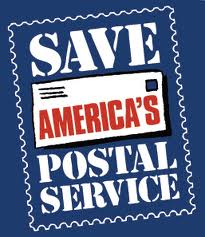 The Postal Service is NOT broke. Indeed, in those four years of loudly deplored “losses,” the service actually produced a $700
The Postal Service is NOT broke. Indeed, in those four years of loudly deplored “losses,” the service actually produced a $700  million operational profit
million operational profit
(despite the worst economy
since the Great Depression).
 FACT: The U.S. Postal Service is funded entirely by revenues from postage.
FACT: The U.S. Postal Service is funded entirely by revenues from postage.
“The Postal Service receives no tax dollars for operating expenses, and relies on the sale of postage, products and services to fund its operations.”
______________________________________________________
 Congress must stop micromanaging the
Congress must stop micromanaging the
Postal Service and
allow critically important reforms, modernization, streamlining operations,
and new sources of revenue.
We don’t need to bail them out; we need to let this U.S. institution save itself.
______________________________________________________
 The USPS nets profits every year. The financial problem it faces comes from a 2006 Congressional mandate that requires the agency to “pre-pay” into a fund that covers health care costs for future retired employees. Under the mandate, the USPS is required to make an annual $5.5 billion payment over ten years, through 2016.These “prepayments” are largely responsible for the USPS’s financial losses over the past four years and the threat of shutdown that looms ahead – take the retirement fund out of the equation, and the postal service would have actually netted $1 billion in profits over this period.
The USPS nets profits every year. The financial problem it faces comes from a 2006 Congressional mandate that requires the agency to “pre-pay” into a fund that covers health care costs for future retired employees. Under the mandate, the USPS is required to make an annual $5.5 billion payment over ten years, through 2016.These “prepayments” are largely responsible for the USPS’s financial losses over the past four years and the threat of shutdown that looms ahead – take the retirement fund out of the equation, and the postal service would have actually netted $1 billion in profits over this period.
This doesn’t mean, however, that the USPS’s financial situation is good. Revenue has been declining for years.
2. The postal service doesn’t rely on taxpayer funds.
Until 1971, mail delivery was handled by the Post Office Department, a Cabinet department in the federal government. Postal worker strikes prompted President Nixon to pass the Postal Reorganization Act in 1971, transforming it into the semi-independent agency we now know as the United States Postal Service. The USPS in its current form runs like a business, relies on postage for revenue and, for the most part, has not used taxpayer money since 1982, when postage stamps became “products” instead of forms of taxation. Taxpayer money is only used in some cases to pay for mailing voter materials to disabled and overseas Americans.
USPS spokespersons have been adamant in emphasizing that they are not requesting taxpayer funds from the federal government to make this year’s payment. Rather, they say, the USPS is asking Congress to authorize access to an estimated $7 billion that they overpaid into the future retiree pension fund in previous years.
3. Junk mail sustains the system.
Although the USPS does manage to turn a profit based on operations alone, it’s a widely known fact that mail volume has dipped over the past decade. As Americans by and large correspond and pay bills online, first-class mail and, as a result, postal revenue have gone into a decline. From 2006 to 2010, mail volume decreased by a hefty 20 percent.
But although the days of custom stationery, handwritten letters and scented envelopes may be long gone, the USPS has been increasingly reliant on junk mail — advertisements, catalogs and other unsolicited mailbox “gifts” — to keep the service afloat. BusinessWeek notes that revenue from junk mail increased by 7.1 percent in the last quarter of 2010 – although volume has not increased since. Donahoe has also expressed optimism that junk mail volume and revenue will increase as the economy improves. But the lower cost of direct mailings means that more junk mail is needed to circulate in the system to make up for the accelerating loss of first-class mail.
4. The proposed cuts are big.
In his testimony last week, Donahoe presented a number of measures that he argues would halt the USPS’s rapid financial decline, including the elimination of the annual pre-fund payment requirement, stopping Saturday mail delivery and terminating a “no-layoff” clause in a contract with unionized postal workers. According to Donahoe, cutting service down to five days a week instead of six, a proposal that has been kicked around for years, would save about $3 billion a year. Donahoe has also urged Congress to allow him to shut down standalone post offices, moving them into convenience stores and supermarkets instead.
Of course, these proposals have been met with resistance, not least by postal workers who stand to lose their jobs, as well as direct mailers, the creators of the junk mail that sustains the system, who argue that Saturday deliveries are crucial times for sending advertisements while recipients have their minds on weekend shopping. Senator Susan Collins (R-Maine) has also argued that ending Saturday delivery could drive mail-order pharmacies and other businesses away from the USPS, further accelerating its losses.
_______________________________________________________
“America’s postal service is a true public service, a grassroots people’s asset that has even more potential than we’re presently tapping to serve the democratic ideal of the common good. Why the hell would we let an elite of small-minded profiteers, ranting ideologues and their political hirelings drop-kick this jewel through the goal posts of corporate greed? This is not a fight merely to save 32,000 post offices and the middle-class jobs they provide — but to advance the BIG IDEA of America itself, the bold, historic notion that “yes, we can” create a society in which we’re all in it together.”
Jim Hightower


